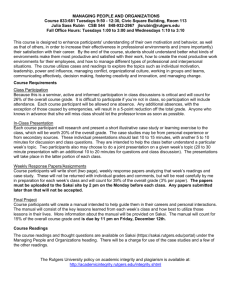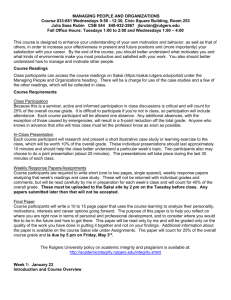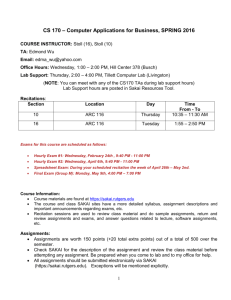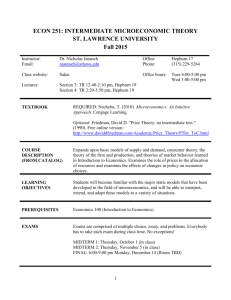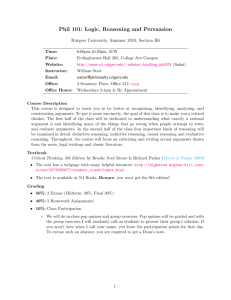Introduction to Social Research
advertisement
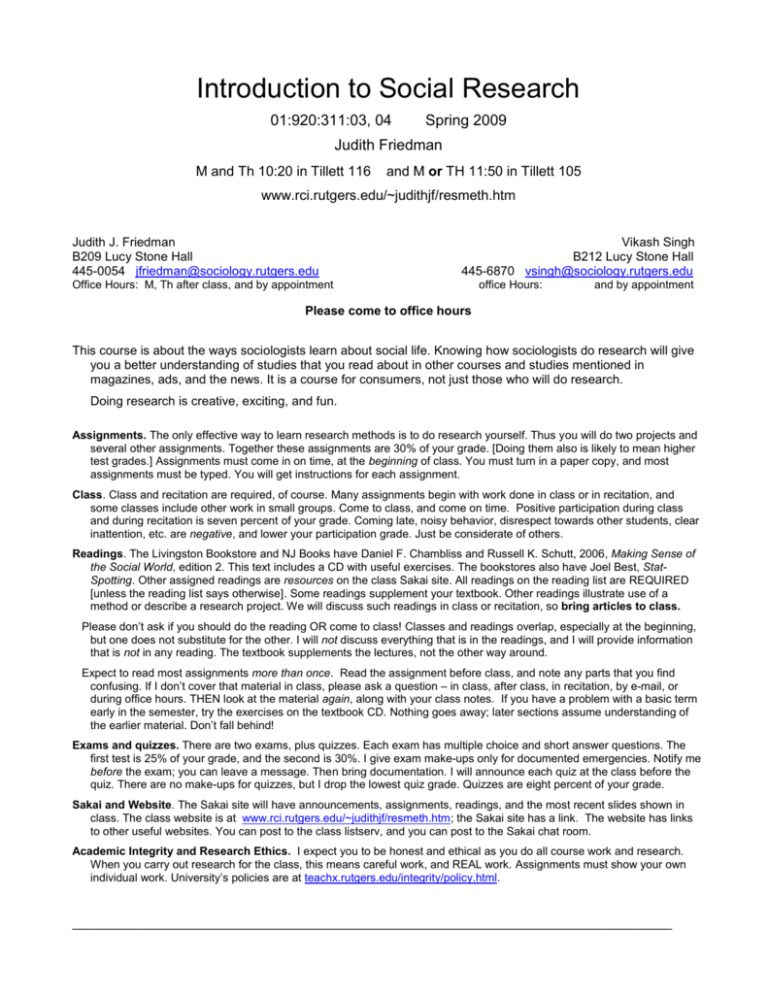
Introduction to Social Research 01:920:311:03, 04 Spring 2009 Judith Friedman M and Th 10:20 in Tillett 116 and M or TH 11:50 in Tillett 105 www.rci.rutgers.edu/~judithjf/resmeth.htm Judith J. Friedman B209 Lucy Stone Hall 445-0054 jfriedman@sociology.rutgers.edu Vikash Singh B212 Lucy Stone Hall 445-6870 vsingh@sociology.rutgers.edu Office Hours: M, Th after class, and by appointment office Hours: and by appointment Please come to office hours This course is about the ways sociologists learn about social life. Knowing how sociologists do research will give you a better understanding of studies that you read about in other courses and studies mentioned in magazines, ads, and the news. It is a course for consumers, not just those who will do research. Doing research is creative, exciting, and fun. Assignments. The only effective way to learn research methods is to do research yourself. Thus you will do two projects and several other assignments. Together these assignments are 30% of your grade. [Doing them also is likely to mean higher test grades.] Assignments must come in on time, at the beginning of class. You must turn in a paper copy, and most assignments must be typed. You will get instructions for each assignment. Class. Class and recitation are required, of course. Many assignments begin with work done in class or in recitation, and some classes include other work in small groups. Come to class, and come on time. Positive participation during class and during recitation is seven percent of your grade. Coming late, noisy behavior, disrespect towards other students, clear inattention, etc. are negative, and lower your participation grade. Just be considerate of others. Readings. The Livingston Bookstore and NJ Books have Daniel F. Chambliss and Russell K. Schutt, 2006, Making Sense of the Social World, edition 2. This text includes a CD with useful exercises. The bookstores also have Joel Best, StatSpotting. Other assigned readings are resources on the class Sakai site. All readings on the reading list are REQUIRED [unless the reading list says otherwise]. Some readings supplement your textbook. Other readings illustrate use of a method or describe a research project. We will discuss such readings in class or recitation, so bring articles to class. Please don’t ask if you should do the reading OR come to class! Classes and readings overlap, especially at the beginning, but one does not substitute for the other. I will not discuss everything that is in the readings, and I will provide information that is not in any reading. The textbook supplements the lectures, not the other way around. Expect to read most assignments more than once. Read the assignment before class, and note any parts that you find confusing. If I don’t cover that material in class, please ask a question – in class, after class, in recitation, by e-mail, or during office hours. THEN look at the material again, along with your class notes. If you have a problem with a basic term early in the semester, try the exercises on the textbook CD. Nothing goes away; later sections assume understanding of the earlier material. Don’t fall behind! Exams and quizzes. There are two exams, plus quizzes. Each exam has multiple choice and short answer questions. The first test is 25% of your grade, and the second is 30%. I give exam make-ups only for documented emergencies. Notify me before the exam; you can leave a message. Then bring documentation. I will announce each quiz at the class before the quiz. There are no make-ups for quizzes, but I drop the lowest quiz grade. Quizzes are eight percent of your grade. Sakai and Website. The Sakai site will have announcements, assignments, readings, and the most recent slides shown in class. The class website is at www.rci.rutgers.edu/~judithjf/resmeth.htm; the Sakai site has a link. The website has links to other useful websites. You can post to the class listserv, and you can post to the Sakai chat room. Academic Integrity and Research Ethics. I expect you to be honest and ethical as you do all course work and research. When you carry out research for the class, this means careful work, and REAL work. Assignments must show your own individual work. University’s policies are at teachx.rutgers.edu/integrity/policy.html. ______________________________________________________________________________________ Introduction to Social Research, J. Friedman, Spring 2009 2 Classroom Integrity. The Department of Sociology encourages the free exchange of ideas in a safe, supportive, and productive classroom environment. To facilitate such an environment, students and faculty must act with mutual respect and common courtesy. Thus, behavior that distracts students and faculty is not acceptable. Such behavior includes cell phone use, surfing the internet, checking email, text messaging, listening to music, reading newspapers, leaving and returning, leaving early without permission, discourteous remarks, and other behaviors specified by individual instructors. Courteous and lawful expression of disagreement with the ideas of the instructor or fellow students is, of course, permitted. If a student engages in disruptive behavior, the instructor, following the University Code of Student Conduct, may direct the student to leave class for the remainder of the class period. Instructors may specify other consequences in their syllabi. Serious verbal assaults, harassment, or defamation of the instructor or other students can lead to university disciplinary proceedings. The University Code of Student Conduct is at http://www.rci.rutgers.edu/~polcomp/judaff/ucsc.shtml. Summary of grading: Test 1 25% Test 2 30% Quizzes 8% Participation (class and recitation) 7% Assignments 30% Assignment grades: content analysis assignment 10% GSS assignment 15% other 5% SCHEDULE AND REQUIRED READINGS* I list readings by topic rather than class session. At the beginning of each class, I announce the assignment for the next class. You are, of course, responsible for knowing what is due and for coming to class prepared. 1. Why take a class in research methods? What IS research in sociology? (Jan 22-27) Chambliss, Daniel F. and Russell K. Schutt, 2006, Making Sense of the Social World, C. 1, Science, Society, and Social Research, 1-20. Look at the Glossary/Index at the end of the book and the CD. Glassner, Barry, 2000, "Killer Kids: Trend-making and Misdirection," Society for the Study of Social Problems Newsletter (Summer): 5-6. Sakai, under resources Look at the class webpage on my website: www.rci.rutgers.edu/~judithjf/resmeth.htm. Sakai has a link. Brody, Jane E., 2002, “Separating gold from junk in medical studies,” NY Times, October 22 Sakai Best, Joel, 2008, Stat-spotting: a field guild to identifying dubious data, 3-13 Friedman, J., 2009, “Early Terms” and “Ways to Study” 2. Research questions and design: Theory, Past Research, Cause (Jan 28-Feb 5) Making Sense of the Social World, C. 2, The Process and Problems of Social Research, 21-40 and 46-48 Making Sense of the Social World, Appendix A, Finding Information, 281-293 Friedman, J., 2008, “Locating research on your issue in the social science journals and in newspapers“ Sakai Allen, Karen, 2003, “Are Pets a Healthy Pleasure?” Current Directions in Psychological Science 12 5(Dec.): 236-239 [this article reviews past research on the topic.] Sakai Best, Joel, Stat-spotting, Blunders and Sources, 17-48 3. Collecting data: Measurement (Feb 6-15) A. General Issues: operationalization, validity, reliability Making Sense of the Social World, C. 3, Conceptualization and Measurement, 51-80 American Society for Microbiology, 2008, press release, fact sheet, and video [scroll down page for video] Bateson, Melisa, 2006, “’Big Brother’ eyes encourage honesty, study shows,” press release from University of Newcastle upon Tyne (June 27) Sakai [The website has a link to the full article, which is not assigned.] Best, Joel, Stat-spotting, Definitions and Measurement, 41-63 * I may change assignments, dates, and so forth during the semester. ______________________________________________________________________________________ Introduction to Social Research, J. Friedman, Spring 2009 3 B. Measurement using data collected through a content analysis of media or systematic observation Making Sense of the Social World, “Content Analysis,” 64-66 [reread] and “visual sociology,” 219-221 Friedman, J., 2008, “Content Analysis” Sakai Grau, Stacy, et al., 2007, “Where’s Tamika Catchings? A content analysis of female athletic endorsers in magazine advertisements,” Journal of Current Issues and Research in Advertising 29 (Spring): 55-65 Sakai Harrell, W. Andrew, 1991, “Factors influencing pedestrian cautiousness in crossing streets,” The Journal of Social Psychology 131 (3): 367 – 372 Sakai Gueguen, Nicholas, et al., 2008, “Sound Level of Environmental Music and Drinking Behavior …,” Alcoholism: Clinical and Experimental Research, 32 (Oct.): 1-2, to “results” [print the entire article, for later] Sakai Preliminary report on content analysis due Monday, February 16. 4. Ethical Research (Feb 16-18) Making Sense of the Social World, in C. 2, But is it Ethical?, 40-46 American Psychological Association, 2005, “Demonstrating the Power of Social Situations via a Simulated Prison Experiment” http://www.psychologymatters.org/spe.html Cohen, Adam, 2008, “Four Decades after Milgram, …,” New York Times (Dec. 29) Sakai Rutgers’ regulations are on its Human Subjects website, orsp.rutgers.edu/Humans/default.php#general. Professional organizations also have statements on ethics. The website has links to the statements of the American Sociological Assn., the American Psychological Assn., and the Academy of Criminal Justice. [These websites are not assigned.] 5. Causation and non-experimental research designs (Feb 19-23) Making Sense of the Social World, C. 5, Causation and Experimental Design, 106-110 only Harrell (reread, looking for the ways he deals with the criteria for cause) Friedman, J., 2007, "Creating a 2-Variable Table" (website) Making Sense of the Social World, C. 9, “Qualitative Data Analysis,” 239-249 and 219-221 Williamson, David, 2002, “Nearness of supermarkets boosts people’s intake …,” Univ. of North Carolina press release (Nov. 1) Sakai “Violent video games desensitize players to real-world violence,” 2005, Univ. of Michigan News Service Sakai 6. Selecting units for study: Populations and samples (Feb 24-March 13) Content analysis paper due Thursday, February 26. A. Representative samples and non-representative samples Making Sense of the Social World, C. 4, Sampling, 86-94; 99-103 Harrell and Gueguen (reread discussions of sample selection) Kohut, Andrew, 2008, “Getting it Wrong,” New York Times (Jan. 10) Sakai Best, Joel, Stat-spotting, 54-56 and 67-68 First test about March 5. [The class and the recitation before the test will include review. Anyone can attend this recitation. There will be a review session the evening before the test also.] B. Representative samples -- when a simple random sample doesn’t work (March 8-12) Making Sense of the Social World, C. 4, Sampling, 94-98 Friedman, J., 2002, “Disproportionate Stratified (random) Samples” Sakai 7. Measurement using “fixed” questions (March 14-24) Making Sense of the Social World, C. 6, Survey Research, 136-161 and Exhibit B1 on page 295 Friedman, Judith, 2004, "Writing questions and creating a questionnaire" Sakai Best, Joel, Stat-spotting, 56-59 * I may change assignments, dates, and so forth during the semester. ______________________________________________________________________________________ Introduction to Social Research, J. Friedman, Spring 2009 4 National Opinion Research Corporation (NORC), 2004, "Trendlets: Measuring Misanthropy," adapted from the GSS website Sakai Friedman, J., 2007, "Background on the General Social Survey (GSS)” Sakai Making Sense of the Social World, reread the section on cluster samples, 95-97 8. Causation in non-experimental research designs (March 26-April 4) Preliminary report on GSS project due Monday, March 30. A. Review basics of Causation Making Sense of the Social World, C. 5, Causation and Experimental Design, 101-106 (reread) Friedman, J., 2007, "Creating a 2-Variable Table" (reread) Best, Joel, Stat-spotting, 82-99 Rosenfeld, Richard, 2004, “Unsolved Crime Decline in Context," Scientific American 290 (2): 82-89 Sakai Sampson, Robert and Stephen Raudenbush, 2001, “Disorder in Urban Neighborhoods – does it lead to crime?” National Institute of Justice, Research in Brief (February) Sakai B. Organizing Data, finding patterns, writing reports Making Sense of the Social World, C. 9, Elementary Data Analysis, 220-244, and reread the first part of this chapter Babbe, Earl, 2004, The Practice of Social Research, C. 15, The Elaboration Model, 421-439 Sakai Friedman, J., 2002, "Types of Three-Variable Hypotheses/Relationships/Findings" Sakai Best, Joel, Stat-spotting, 64-66 and 69-82 9. Causation: True experiments, quasi-experiments (April 5-15) Making Sense of the Social World, C.5, Causation and Experimental Design, 106-132 High/Point, 2005, “Perry Preschool at 40” and David Kirp, 2004, “Life Way After Head Start,” New York Times Magazine (Nov. 21): 32-38 Sakai Lorenzen, Lisa, Frederick Grieve, and Adrian Thomas, 2004, “Exposure to Muscular Male Models Decreases Men’s Body Satisfaction,” Sex Roles 11/12 (Dec.): 743-748 Sakai Gueguen, Nicolas, et al., 2008, “Sound Level of Environment Music … “ Read entire article this time. 10. Less structured interviews and Fieldwork (April 16-29) A. Unstructured Interviews Making Sense of the Social World, C.7, Qualitative Methods, 179-189 Weiss, Robert S., 2004, “In their own words: making the most of qualitative interviews,” Contexts 3 (Fall): 44-50 Sakai Lee, Jennifer, 2000, “The Salience of Race in everyday Life,” Work and Occupations 27 (Aug.): 353-376 Sakai GSS paper due Monday, April 20. B. Fieldwork Making Sense of the Social World, C. 7, 166-179; 185-187 and C. 8, Qualitative Data Analysis, 193-208, 225-6 Liebow, Elliot, 1993, Tell Them Who I Am, Free Press, vii-xii, xvii, 25 -49, and 319-326 Sakai 11. Applied social research and Overview of Research (April 30 - May 5) Making Sense of the Social World, C. 10, Reviewing, Proposing and Reporting Research, 257-266, 273-280 Reread: Harrell, High/Point and Kirp, and Sampson and Raudenbush Kocieniewski, David, 2002, "Study suggests racial gap in speeding in NJ," New York Times (March 21): B1, 6 Sakai Best, Joel, Stat-spotting, 96-99 and 103-116 Second Test Friday, May 8, 8:30 am * I may change assignments, dates, and so forth during the semester. ______________________________________________________________________________________

